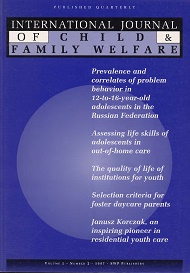Prevalence and correlates of problem behavior in 12-to-16-year-old adolescents in the Russian Federation
Abstract
This study on problem behavior in 12-to-16-year-old adolescents in the Russian Federation had two objectives: 1) to provide baseline data on the prevalence of behavioral and emotional problems, and 2) to explore the relation between problem behavior in adolescents and selected demographic, child, and family factors. By means of a three-stage stratified sampling design a sample was drawn that was representative of gender, age, family's socio-economic status, region, and type of community in the Russian Federation. Parents completed two questionnaires: 1) the Child Behavior Checklist (CBCL; Achenbach, 1991), in which they reported on children’s competence and problem behavior during the last six months, and 2) an additional questionnaire containing specific questions on the child’s living conditions, life history and family relations. These questions were added in order to detect demographic, child and family factors co-occurring with deviant behavior in teenagers. Skilled interviewers visited the parents at home and administered both questionnaires. A total of 2,002 respondents participated in the study, approximately 71.0% of all parents visited. Non-response was mainly due to refusals. According to their parents’ reports, Russian teenagers showed a wide variety of behavioral and emotional problems. Some problems had very high prevalence rates and seemed to be characteristic for young Russian people, i.e. withdrawal behavior, psychosomatic problems and delinquency. Many problems were significantly related to the adolescent’s gender: internalizing problems (anxiety, depressive feelings, psychosomatic complaints) were reported as being more typical for girls, externalizing problems (aggression, delinquency) as more typical for boys. Only a few small significant age differences in the prevalence of behavioral and emotional problems were found. Demographic factors co-occurring with high levels of problem behavior in teenagers were area of residence (e.g. living in large cities like Moscow and St. Petersburg), the most recent monthly income of the family and the parents perception of their financial position. Higher levels of problem behavior were also noted in adolescents who had moved or changed school frequently, in adolescents who did not have a room of their own in the house or apartment, and in adolescents stemming from families in which at least one member manifested a chronic somatic or psychological disease. The Russian version of the CBCL has proven moderate reliability and validity in this sample. Nevertheless, statistical norms based on large Russian samples of non-referred and referred adolescents should be developed in order to refine the diagnostic use of the CBCL in the Russian population.

